WeWork's Business Strategy & CSR
VerifiedAdded on 2020/03/16
|9
|2779
|126
AI Summary
The assignment examines WeWork's business strategy by applying Porter's Five Forces and SWOT analysis frameworks. It evaluates the competitive landscape within the coworking industry and identifies both internal strengths and weaknesses as well as external opportunities and threats facing WeWork. The paper also discusses how corporate social responsibility (CSR) can contribute to mitigating challenges and enhancing WeWork's strategic positioning in the long term.
Contribute Materials
Your contribution can guide someone’s learning journey. Share your
documents today.
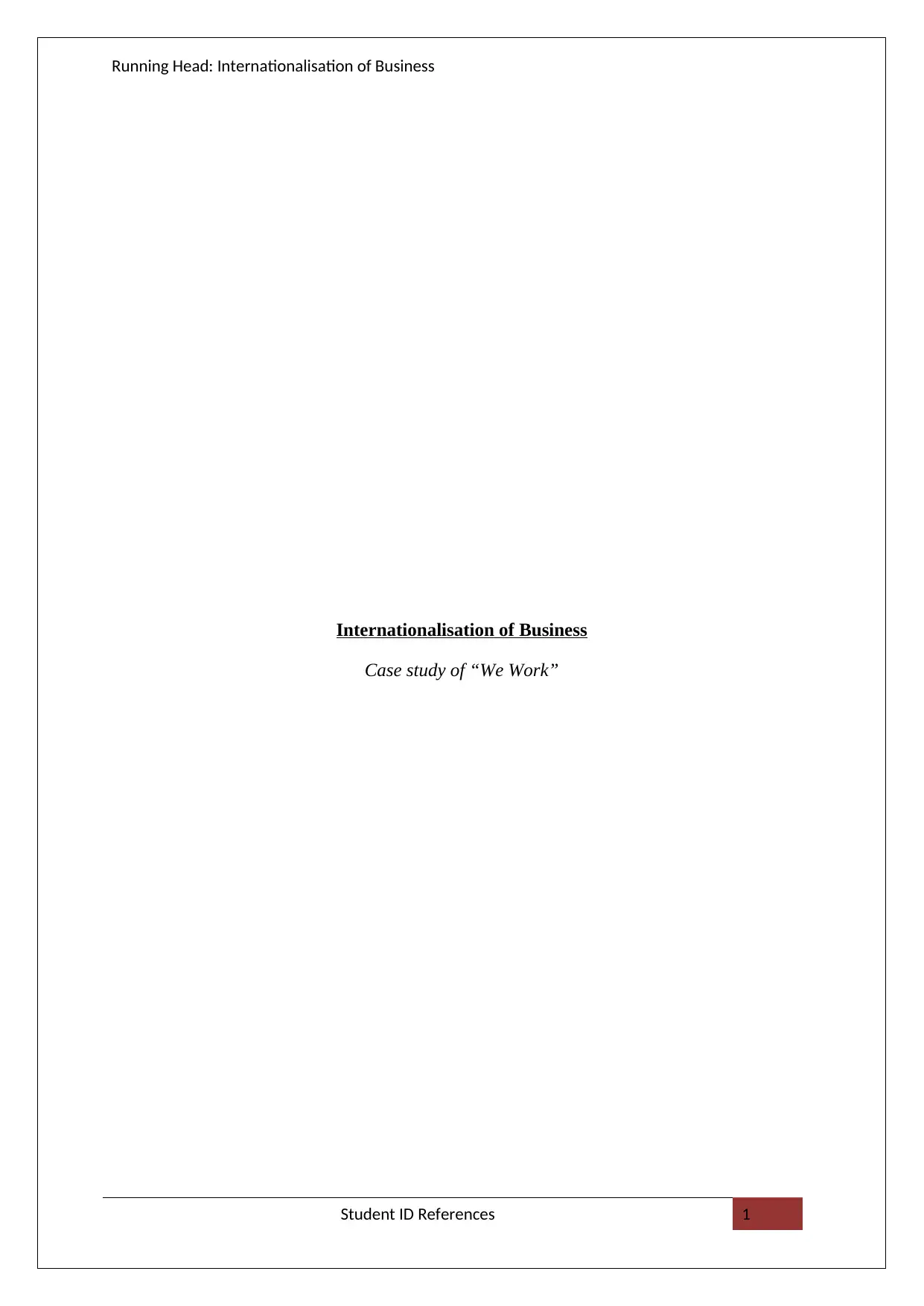
Running Head: Internationalisation of Business
Internationalisation of Business
Case study of “We Work”
Student ID References 1
Internationalisation of Business
Case study of “We Work”
Student ID References 1
Secure Best Marks with AI Grader
Need help grading? Try our AI Grader for instant feedback on your assignments.
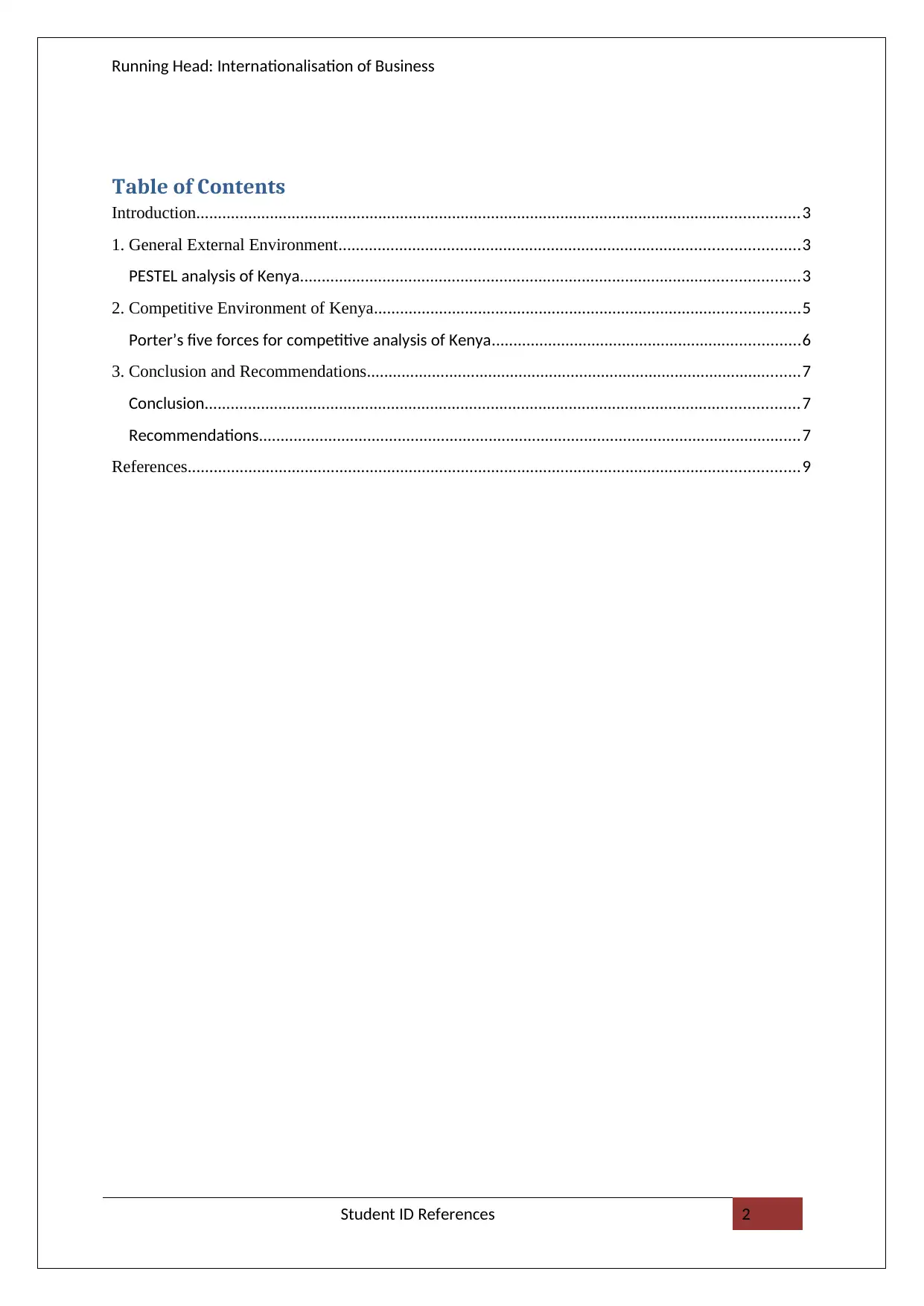
Running Head: Internationalisation of Business
Table of Contents
Introduction...........................................................................................................................................3
1. General External Environment..........................................................................................................3
PESTEL analysis of Kenya...................................................................................................................3
2. Competitive Environment of Kenya..................................................................................................5
Porter’s five forces for competitive analysis of Kenya.......................................................................6
3. Conclusion and Recommendations....................................................................................................7
Conclusion.........................................................................................................................................7
Recommendations.............................................................................................................................7
References.............................................................................................................................................9
Student ID References 2
Table of Contents
Introduction...........................................................................................................................................3
1. General External Environment..........................................................................................................3
PESTEL analysis of Kenya...................................................................................................................3
2. Competitive Environment of Kenya..................................................................................................5
Porter’s five forces for competitive analysis of Kenya.......................................................................6
3. Conclusion and Recommendations....................................................................................................7
Conclusion.........................................................................................................................................7
Recommendations.............................................................................................................................7
References.............................................................................................................................................9
Student ID References 2
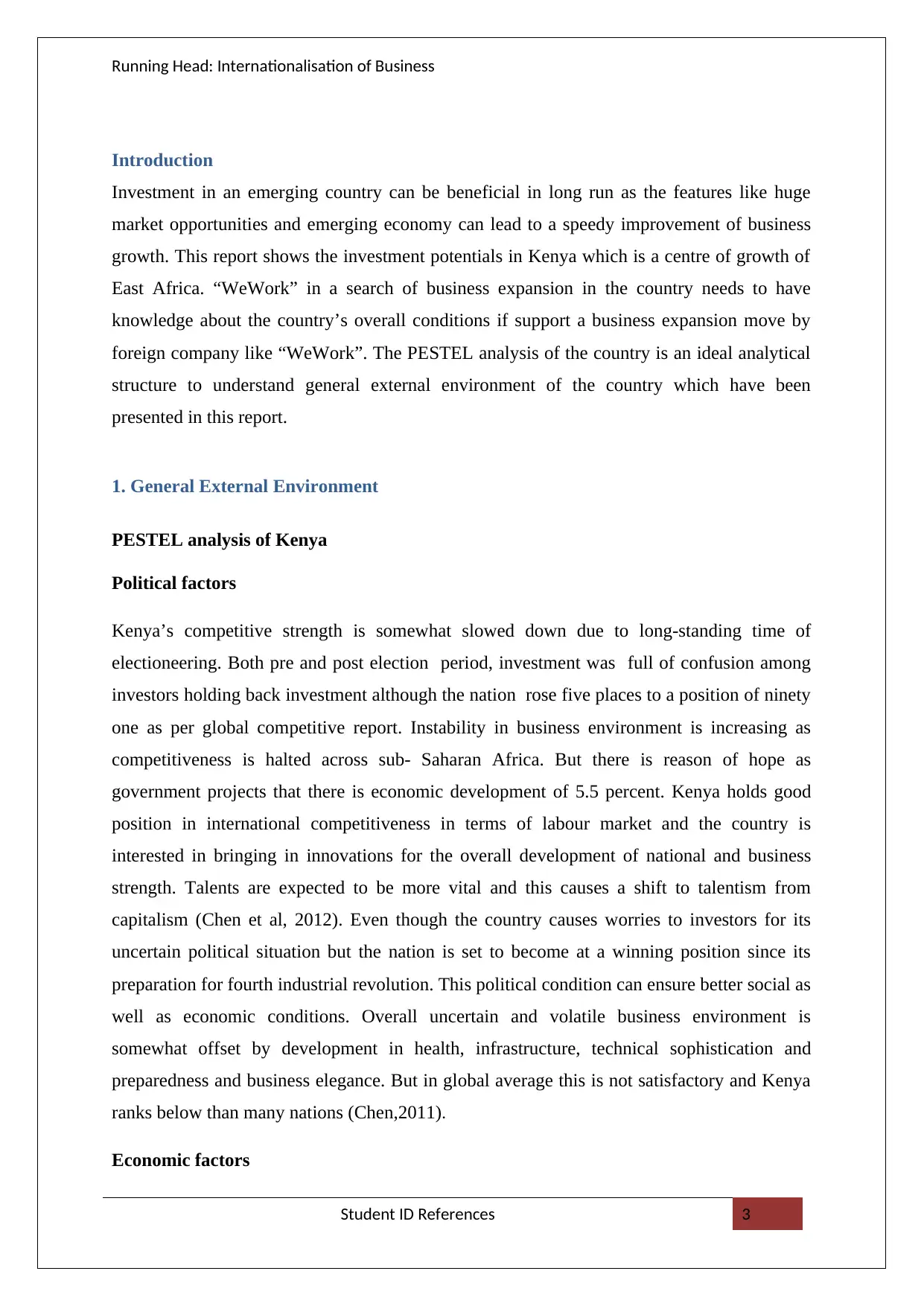
Running Head: Internationalisation of Business
Introduction
Investment in an emerging country can be beneficial in long run as the features like huge
market opportunities and emerging economy can lead to a speedy improvement of business
growth. This report shows the investment potentials in Kenya which is a centre of growth of
East Africa. “WeWork” in a search of business expansion in the country needs to have
knowledge about the country’s overall conditions if support a business expansion move by
foreign company like “WeWork”. The PESTEL analysis of the country is an ideal analytical
structure to understand general external environment of the country which have been
presented in this report.
1. General External Environment
PESTEL analysis of Kenya
Political factors
Kenya’s competitive strength is somewhat slowed down due to long-standing time of
electioneering. Both pre and post election period, investment was full of confusion among
investors holding back investment although the nation rose five places to a position of ninety
one as per global competitive report. Instability in business environment is increasing as
competitiveness is halted across sub- Saharan Africa. But there is reason of hope as
government projects that there is economic development of 5.5 percent. Kenya holds good
position in international competitiveness in terms of labour market and the country is
interested in bringing in innovations for the overall development of national and business
strength. Talents are expected to be more vital and this causes a shift to talentism from
capitalism (Chen et al, 2012). Even though the country causes worries to investors for its
uncertain political situation but the nation is set to become at a winning position since its
preparation for fourth industrial revolution. This political condition can ensure better social as
well as economic conditions. Overall uncertain and volatile business environment is
somewhat offset by development in health, infrastructure, technical sophistication and
preparedness and business elegance. But in global average this is not satisfactory and Kenya
ranks below than many nations (Chen,2011).
Economic factors
Student ID References 3
Introduction
Investment in an emerging country can be beneficial in long run as the features like huge
market opportunities and emerging economy can lead to a speedy improvement of business
growth. This report shows the investment potentials in Kenya which is a centre of growth of
East Africa. “WeWork” in a search of business expansion in the country needs to have
knowledge about the country’s overall conditions if support a business expansion move by
foreign company like “WeWork”. The PESTEL analysis of the country is an ideal analytical
structure to understand general external environment of the country which have been
presented in this report.
1. General External Environment
PESTEL analysis of Kenya
Political factors
Kenya’s competitive strength is somewhat slowed down due to long-standing time of
electioneering. Both pre and post election period, investment was full of confusion among
investors holding back investment although the nation rose five places to a position of ninety
one as per global competitive report. Instability in business environment is increasing as
competitiveness is halted across sub- Saharan Africa. But there is reason of hope as
government projects that there is economic development of 5.5 percent. Kenya holds good
position in international competitiveness in terms of labour market and the country is
interested in bringing in innovations for the overall development of national and business
strength. Talents are expected to be more vital and this causes a shift to talentism from
capitalism (Chen et al, 2012). Even though the country causes worries to investors for its
uncertain political situation but the nation is set to become at a winning position since its
preparation for fourth industrial revolution. This political condition can ensure better social as
well as economic conditions. Overall uncertain and volatile business environment is
somewhat offset by development in health, infrastructure, technical sophistication and
preparedness and business elegance. But in global average this is not satisfactory and Kenya
ranks below than many nations (Chen,2011).
Economic factors
Student ID References 3
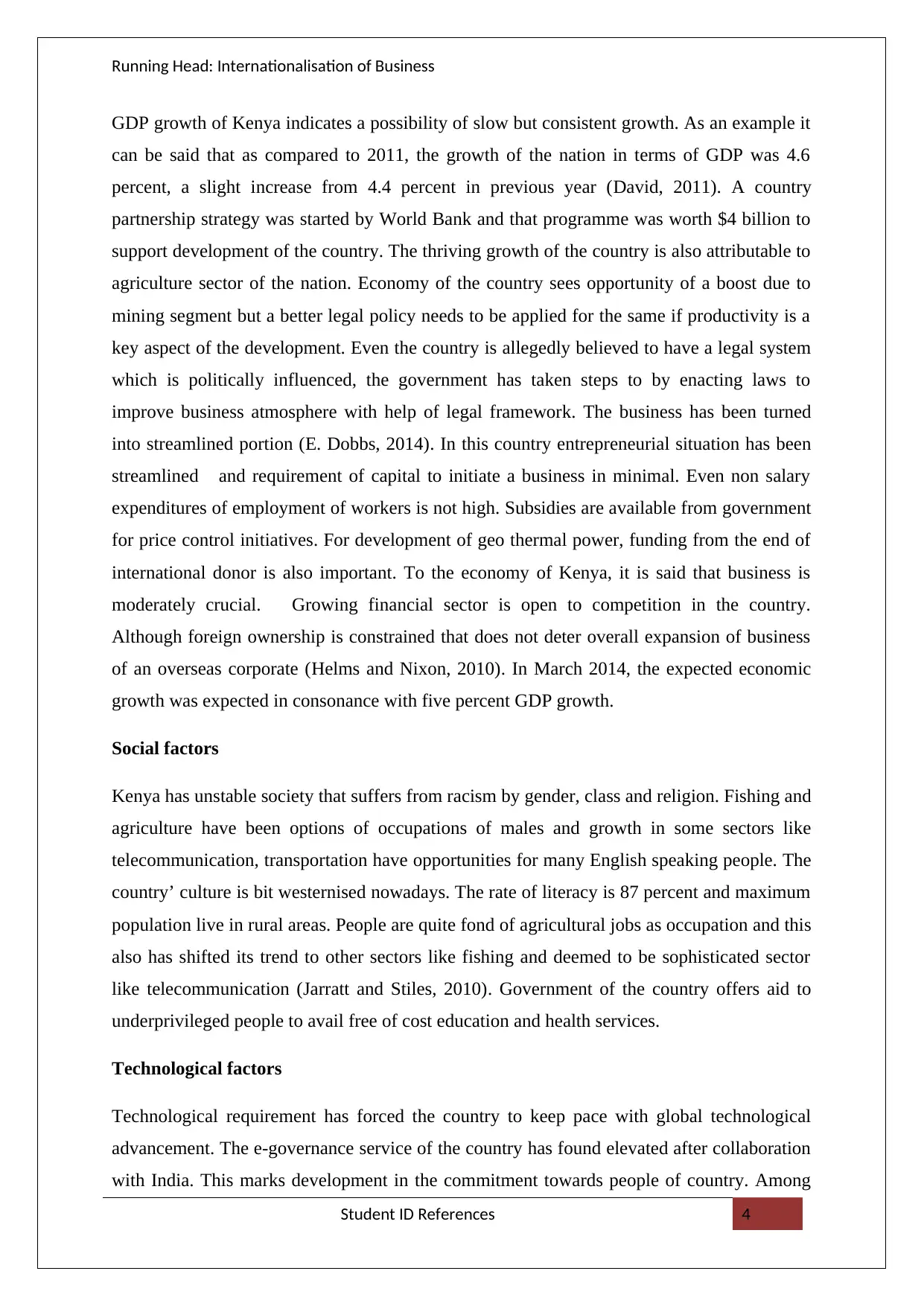
Running Head: Internationalisation of Business
GDP growth of Kenya indicates a possibility of slow but consistent growth. As an example it
can be said that as compared to 2011, the growth of the nation in terms of GDP was 4.6
percent, a slight increase from 4.4 percent in previous year (David, 2011). A country
partnership strategy was started by World Bank and that programme was worth $4 billion to
support development of the country. The thriving growth of the country is also attributable to
agriculture sector of the nation. Economy of the country sees opportunity of a boost due to
mining segment but a better legal policy needs to be applied for the same if productivity is a
key aspect of the development. Even the country is allegedly believed to have a legal system
which is politically influenced, the government has taken steps to by enacting laws to
improve business atmosphere with help of legal framework. The business has been turned
into streamlined portion (E. Dobbs, 2014). In this country entrepreneurial situation has been
streamlined and requirement of capital to initiate a business in minimal. Even non salary
expenditures of employment of workers is not high. Subsidies are available from government
for price control initiatives. For development of geo thermal power, funding from the end of
international donor is also important. To the economy of Kenya, it is said that business is
moderately crucial. Growing financial sector is open to competition in the country.
Although foreign ownership is constrained that does not deter overall expansion of business
of an overseas corporate (Helms and Nixon, 2010). In March 2014, the expected economic
growth was expected in consonance with five percent GDP growth.
Social factors
Kenya has unstable society that suffers from racism by gender, class and religion. Fishing and
agriculture have been options of occupations of males and growth in some sectors like
telecommunication, transportation have opportunities for many English speaking people. The
country’ culture is bit westernised nowadays. The rate of literacy is 87 percent and maximum
population live in rural areas. People are quite fond of agricultural jobs as occupation and this
also has shifted its trend to other sectors like fishing and deemed to be sophisticated sector
like telecommunication (Jarratt and Stiles, 2010). Government of the country offers aid to
underprivileged people to avail free of cost education and health services.
Technological factors
Technological requirement has forced the country to keep pace with global technological
advancement. The e-governance service of the country has found elevated after collaboration
with India. This marks development in the commitment towards people of country. Among
Student ID References 4
GDP growth of Kenya indicates a possibility of slow but consistent growth. As an example it
can be said that as compared to 2011, the growth of the nation in terms of GDP was 4.6
percent, a slight increase from 4.4 percent in previous year (David, 2011). A country
partnership strategy was started by World Bank and that programme was worth $4 billion to
support development of the country. The thriving growth of the country is also attributable to
agriculture sector of the nation. Economy of the country sees opportunity of a boost due to
mining segment but a better legal policy needs to be applied for the same if productivity is a
key aspect of the development. Even the country is allegedly believed to have a legal system
which is politically influenced, the government has taken steps to by enacting laws to
improve business atmosphere with help of legal framework. The business has been turned
into streamlined portion (E. Dobbs, 2014). In this country entrepreneurial situation has been
streamlined and requirement of capital to initiate a business in minimal. Even non salary
expenditures of employment of workers is not high. Subsidies are available from government
for price control initiatives. For development of geo thermal power, funding from the end of
international donor is also important. To the economy of Kenya, it is said that business is
moderately crucial. Growing financial sector is open to competition in the country.
Although foreign ownership is constrained that does not deter overall expansion of business
of an overseas corporate (Helms and Nixon, 2010). In March 2014, the expected economic
growth was expected in consonance with five percent GDP growth.
Social factors
Kenya has unstable society that suffers from racism by gender, class and religion. Fishing and
agriculture have been options of occupations of males and growth in some sectors like
telecommunication, transportation have opportunities for many English speaking people. The
country’ culture is bit westernised nowadays. The rate of literacy is 87 percent and maximum
population live in rural areas. People are quite fond of agricultural jobs as occupation and this
also has shifted its trend to other sectors like fishing and deemed to be sophisticated sector
like telecommunication (Jarratt and Stiles, 2010). Government of the country offers aid to
underprivileged people to avail free of cost education and health services.
Technological factors
Technological requirement has forced the country to keep pace with global technological
advancement. The e-governance service of the country has found elevated after collaboration
with India. This marks development in the commitment towards people of country. Among
Student ID References 4
Secure Best Marks with AI Grader
Need help grading? Try our AI Grader for instant feedback on your assignments.
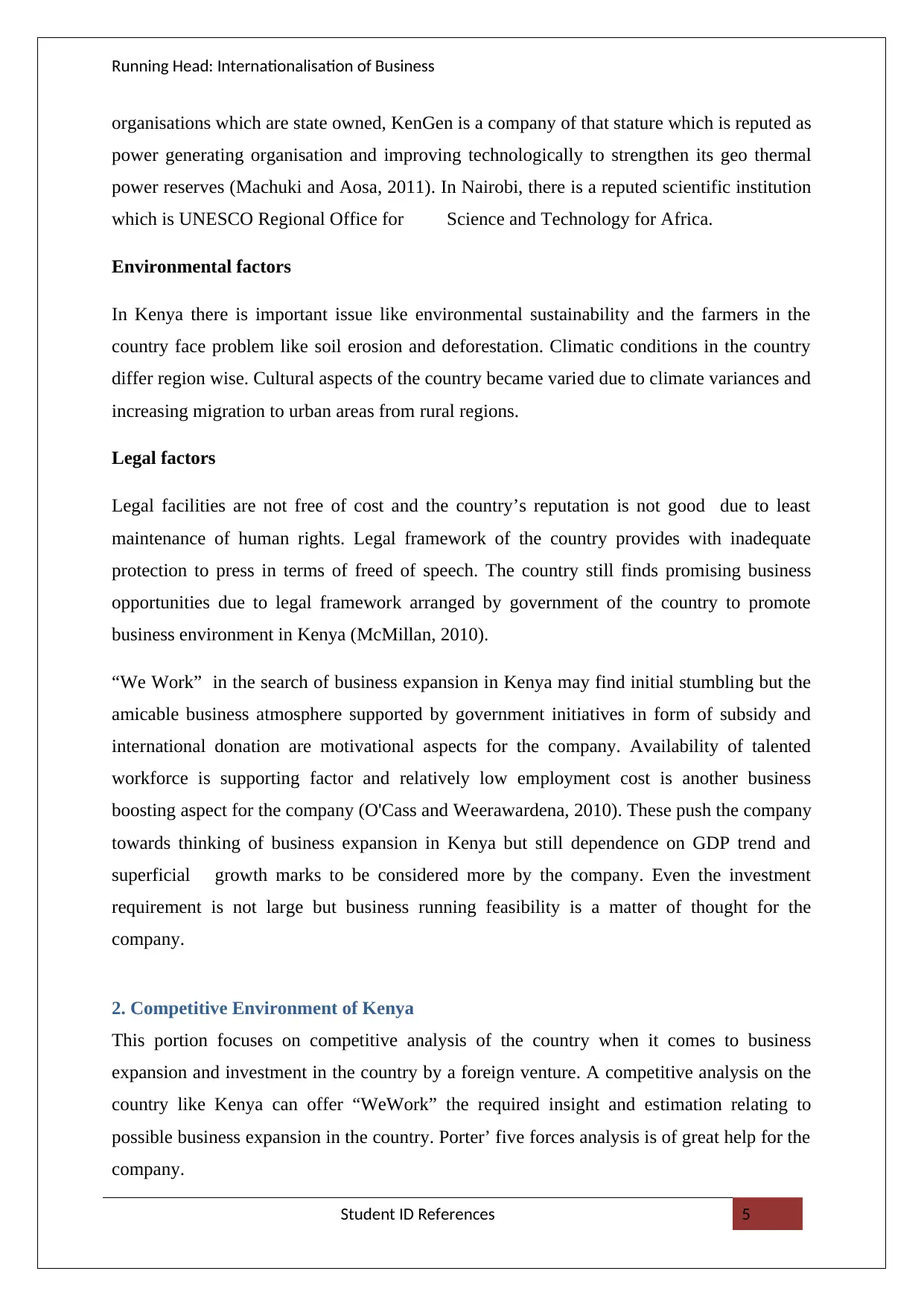
Running Head: Internationalisation of Business
organisations which are state owned, KenGen is a company of that stature which is reputed as
power generating organisation and improving technologically to strengthen its geo thermal
power reserves (Machuki and Aosa, 2011). In Nairobi, there is a reputed scientific institution
which is UNESCO Regional Office for Science and Technology for Africa.
Environmental factors
In Kenya there is important issue like environmental sustainability and the farmers in the
country face problem like soil erosion and deforestation. Climatic conditions in the country
differ region wise. Cultural aspects of the country became varied due to climate variances and
increasing migration to urban areas from rural regions.
Legal factors
Legal facilities are not free of cost and the country’s reputation is not good due to least
maintenance of human rights. Legal framework of the country provides with inadequate
protection to press in terms of freed of speech. The country still finds promising business
opportunities due to legal framework arranged by government of the country to promote
business environment in Kenya (McMillan, 2010).
“We Work” in the search of business expansion in Kenya may find initial stumbling but the
amicable business atmosphere supported by government initiatives in form of subsidy and
international donation are motivational aspects for the company. Availability of talented
workforce is supporting factor and relatively low employment cost is another business
boosting aspect for the company (O'Cass and Weerawardena, 2010). These push the company
towards thinking of business expansion in Kenya but still dependence on GDP trend and
superficial growth marks to be considered more by the company. Even the investment
requirement is not large but business running feasibility is a matter of thought for the
company.
2. Competitive Environment of Kenya
This portion focuses on competitive analysis of the country when it comes to business
expansion and investment in the country by a foreign venture. A competitive analysis on the
country like Kenya can offer “WeWork” the required insight and estimation relating to
possible business expansion in the country. Porter’ five forces analysis is of great help for the
company.
Student ID References 5
organisations which are state owned, KenGen is a company of that stature which is reputed as
power generating organisation and improving technologically to strengthen its geo thermal
power reserves (Machuki and Aosa, 2011). In Nairobi, there is a reputed scientific institution
which is UNESCO Regional Office for Science and Technology for Africa.
Environmental factors
In Kenya there is important issue like environmental sustainability and the farmers in the
country face problem like soil erosion and deforestation. Climatic conditions in the country
differ region wise. Cultural aspects of the country became varied due to climate variances and
increasing migration to urban areas from rural regions.
Legal factors
Legal facilities are not free of cost and the country’s reputation is not good due to least
maintenance of human rights. Legal framework of the country provides with inadequate
protection to press in terms of freed of speech. The country still finds promising business
opportunities due to legal framework arranged by government of the country to promote
business environment in Kenya (McMillan, 2010).
“We Work” in the search of business expansion in Kenya may find initial stumbling but the
amicable business atmosphere supported by government initiatives in form of subsidy and
international donation are motivational aspects for the company. Availability of talented
workforce is supporting factor and relatively low employment cost is another business
boosting aspect for the company (O'Cass and Weerawardena, 2010). These push the company
towards thinking of business expansion in Kenya but still dependence on GDP trend and
superficial growth marks to be considered more by the company. Even the investment
requirement is not large but business running feasibility is a matter of thought for the
company.
2. Competitive Environment of Kenya
This portion focuses on competitive analysis of the country when it comes to business
expansion and investment in the country by a foreign venture. A competitive analysis on the
country like Kenya can offer “WeWork” the required insight and estimation relating to
possible business expansion in the country. Porter’ five forces analysis is of great help for the
company.
Student ID References 5

Running Head: Internationalisation of Business
Porter’s five forces for competitive analysis of Kenya
The profitability for the company on the country can be measured by analysing the effects of
the five forces on the competition and industry. Threat of new entrant is low if there are
barriers to entry for a foreign company. In Kenya, threat of new entrants differ industry wise.
Capital investment requirement is low in the country and for maximum industry the customer
switching cost is moderate (Porter and Heppelmann, 2014). This works in support of a new
company’s perspective and “WeWork can find a convenient entry in the Kenyan Market.
The next force is bargaining power of suppliers. This is high in the country as suppliers
generally quote higher prices for raw materials and the buyers like organisations are often
forced to pay higher prices. But the quality is often compromised as the high bargaining
power of the suppliers keep them in such a position to cut on the quality aspects as an instinct
from their superior position (Tanriverdi, Rai and Venkatraman, 2010). This is deterrent for
the “WeWork” as it is supposed to confront with the same situation there, in event of
requirement of raw materials for the business. The another force is bargaining power of buyer
and this is in Kenya is relatively strong because of they are price sensitive and the firms in
almost every sector find switching cost to other firms are low from customers’ point of view.
This possesses a scenario wherein customers or buyers have more dominance than firms and
this is not business supporting conditions which is a matter of concern for “We Work”. The
next force is threat of substitutes. Buyers usually find low switching costs to another brand
for availing products. This becomes more complicated when the market is awash of substitute
products with price variations. This creates options for customers to select their preferred
brands (Vecchiato and Roveda, 2010). Therefore the company “WeWork” can focus on the
quality and of products and services at an affordable cost to redirect customers’ attention
from substitute services and products. Another force is rivalry among the competitors in the
industry. This is high in the country as low exit barrier and presence of many substitute
products and services, This generally reduces profits and as customers’ acquisition becomes
priority with another attention on providing them with better quality products and that is too
in low cost (Vecchiato and Roveda, 2010). This has to be kept in consideration by
“WeWork” and the strategy formation needs to be accordingly and also knowledge
development by assessing the mentioned five forces in the industry in the country like Kenya.
Student ID References 6
Porter’s five forces for competitive analysis of Kenya
The profitability for the company on the country can be measured by analysing the effects of
the five forces on the competition and industry. Threat of new entrant is low if there are
barriers to entry for a foreign company. In Kenya, threat of new entrants differ industry wise.
Capital investment requirement is low in the country and for maximum industry the customer
switching cost is moderate (Porter and Heppelmann, 2014). This works in support of a new
company’s perspective and “WeWork can find a convenient entry in the Kenyan Market.
The next force is bargaining power of suppliers. This is high in the country as suppliers
generally quote higher prices for raw materials and the buyers like organisations are often
forced to pay higher prices. But the quality is often compromised as the high bargaining
power of the suppliers keep them in such a position to cut on the quality aspects as an instinct
from their superior position (Tanriverdi, Rai and Venkatraman, 2010). This is deterrent for
the “WeWork” as it is supposed to confront with the same situation there, in event of
requirement of raw materials for the business. The another force is bargaining power of buyer
and this is in Kenya is relatively strong because of they are price sensitive and the firms in
almost every sector find switching cost to other firms are low from customers’ point of view.
This possesses a scenario wherein customers or buyers have more dominance than firms and
this is not business supporting conditions which is a matter of concern for “We Work”. The
next force is threat of substitutes. Buyers usually find low switching costs to another brand
for availing products. This becomes more complicated when the market is awash of substitute
products with price variations. This creates options for customers to select their preferred
brands (Vecchiato and Roveda, 2010). Therefore the company “WeWork” can focus on the
quality and of products and services at an affordable cost to redirect customers’ attention
from substitute services and products. Another force is rivalry among the competitors in the
industry. This is high in the country as low exit barrier and presence of many substitute
products and services, This generally reduces profits and as customers’ acquisition becomes
priority with another attention on providing them with better quality products and that is too
in low cost (Vecchiato and Roveda, 2010). This has to be kept in consideration by
“WeWork” and the strategy formation needs to be accordingly and also knowledge
development by assessing the mentioned five forces in the industry in the country like Kenya.
Student ID References 6
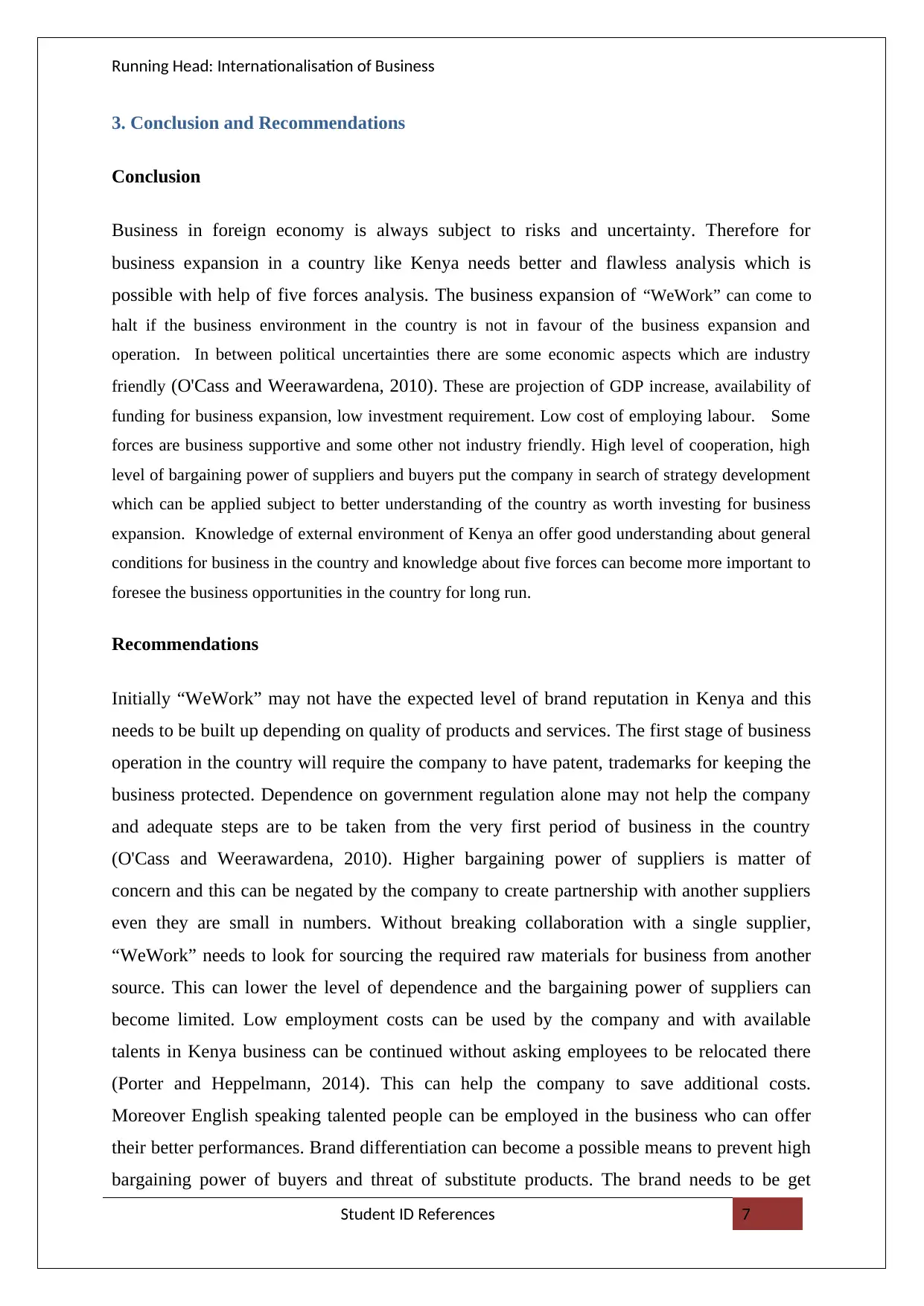
Running Head: Internationalisation of Business
3. Conclusion and Recommendations
Conclusion
Business in foreign economy is always subject to risks and uncertainty. Therefore for
business expansion in a country like Kenya needs better and flawless analysis which is
possible with help of five forces analysis. The business expansion of “WeWork” can come to
halt if the business environment in the country is not in favour of the business expansion and
operation. In between political uncertainties there are some economic aspects which are industry
friendly (O'Cass and Weerawardena, 2010). These are projection of GDP increase, availability of
funding for business expansion, low investment requirement. Low cost of employing labour. Some
forces are business supportive and some other not industry friendly. High level of cooperation, high
level of bargaining power of suppliers and buyers put the company in search of strategy development
which can be applied subject to better understanding of the country as worth investing for business
expansion. Knowledge of external environment of Kenya an offer good understanding about general
conditions for business in the country and knowledge about five forces can become more important to
foresee the business opportunities in the country for long run.
Recommendations
Initially “WeWork” may not have the expected level of brand reputation in Kenya and this
needs to be built up depending on quality of products and services. The first stage of business
operation in the country will require the company to have patent, trademarks for keeping the
business protected. Dependence on government regulation alone may not help the company
and adequate steps are to be taken from the very first period of business in the country
(O'Cass and Weerawardena, 2010). Higher bargaining power of suppliers is matter of
concern and this can be negated by the company to create partnership with another suppliers
even they are small in numbers. Without breaking collaboration with a single supplier,
“WeWork” needs to look for sourcing the required raw materials for business from another
source. This can lower the level of dependence and the bargaining power of suppliers can
become limited. Low employment costs can be used by the company and with available
talents in Kenya business can be continued without asking employees to be relocated there
(Porter and Heppelmann, 2014). This can help the company to save additional costs.
Moreover English speaking talented people can be employed in the business who can offer
their better performances. Brand differentiation can become a possible means to prevent high
bargaining power of buyers and threat of substitute products. The brand needs to be get
Student ID References 7
3. Conclusion and Recommendations
Conclusion
Business in foreign economy is always subject to risks and uncertainty. Therefore for
business expansion in a country like Kenya needs better and flawless analysis which is
possible with help of five forces analysis. The business expansion of “WeWork” can come to
halt if the business environment in the country is not in favour of the business expansion and
operation. In between political uncertainties there are some economic aspects which are industry
friendly (O'Cass and Weerawardena, 2010). These are projection of GDP increase, availability of
funding for business expansion, low investment requirement. Low cost of employing labour. Some
forces are business supportive and some other not industry friendly. High level of cooperation, high
level of bargaining power of suppliers and buyers put the company in search of strategy development
which can be applied subject to better understanding of the country as worth investing for business
expansion. Knowledge of external environment of Kenya an offer good understanding about general
conditions for business in the country and knowledge about five forces can become more important to
foresee the business opportunities in the country for long run.
Recommendations
Initially “WeWork” may not have the expected level of brand reputation in Kenya and this
needs to be built up depending on quality of products and services. The first stage of business
operation in the country will require the company to have patent, trademarks for keeping the
business protected. Dependence on government regulation alone may not help the company
and adequate steps are to be taken from the very first period of business in the country
(O'Cass and Weerawardena, 2010). Higher bargaining power of suppliers is matter of
concern and this can be negated by the company to create partnership with another suppliers
even they are small in numbers. Without breaking collaboration with a single supplier,
“WeWork” needs to look for sourcing the required raw materials for business from another
source. This can lower the level of dependence and the bargaining power of suppliers can
become limited. Low employment costs can be used by the company and with available
talents in Kenya business can be continued without asking employees to be relocated there
(Porter and Heppelmann, 2014). This can help the company to save additional costs.
Moreover English speaking talented people can be employed in the business who can offer
their better performances. Brand differentiation can become a possible means to prevent high
bargaining power of buyers and threat of substitute products. The brand needs to be get
Student ID References 7
Paraphrase This Document
Need a fresh take? Get an instant paraphrase of this document with our AI Paraphraser

Running Head: Internationalisation of Business
familiar with the local people of the country and also gradually the perceptible impression
of the brand goes higher among customers. The business environment although appears to be
amicable to somewhat due to legal framework by initiates taken by government but the
development of strategies for keeping business afloat in the new territory among uncertainty
becomes imperative for “WeWork”. The overall investment is not concern free but again the
firm needs to seize each single opportunity to strengthen its brand value and brand image in
the country (Vecchiato and Roveda, 2010). If not possible in the first phase of business but
with advancement of time corporate social responsibilities can enable “WeWork” towards
better positioning and conquer over the impediments for the business out there.
Student ID References 8
familiar with the local people of the country and also gradually the perceptible impression
of the brand goes higher among customers. The business environment although appears to be
amicable to somewhat due to legal framework by initiates taken by government but the
development of strategies for keeping business afloat in the new territory among uncertainty
becomes imperative for “WeWork”. The overall investment is not concern free but again the
firm needs to seize each single opportunity to strengthen its brand value and brand image in
the country (Vecchiato and Roveda, 2010). If not possible in the first phase of business but
with advancement of time corporate social responsibilities can enable “WeWork” towards
better positioning and conquer over the impediments for the business out there.
Student ID References 8
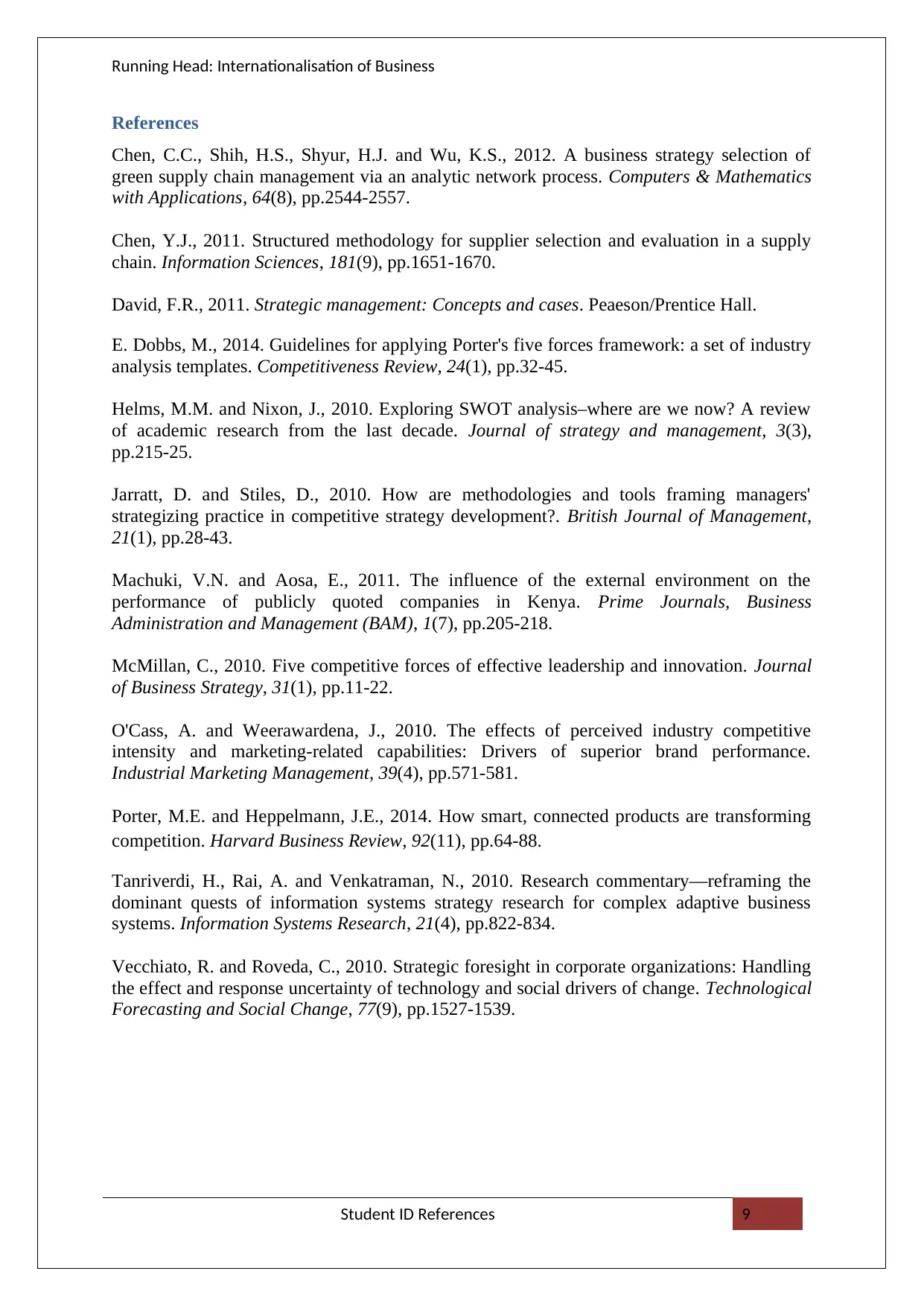
Running Head: Internationalisation of Business
References
Chen, C.C., Shih, H.S., Shyur, H.J. and Wu, K.S., 2012. A business strategy selection of
green supply chain management via an analytic network process. Computers & Mathematics
with Applications, 64(8), pp.2544-2557.
Chen, Y.J., 2011. Structured methodology for supplier selection and evaluation in a supply
chain. Information Sciences, 181(9), pp.1651-1670.
David, F.R., 2011. Strategic management: Concepts and cases. Peaeson/Prentice Hall.
E. Dobbs, M., 2014. Guidelines for applying Porter's five forces framework: a set of industry
analysis templates. Competitiveness Review, 24(1), pp.32-45.
Helms, M.M. and Nixon, J., 2010. Exploring SWOT analysis–where are we now? A review
of academic research from the last decade. Journal of strategy and management, 3(3),
pp.215-25.
Jarratt, D. and Stiles, D., 2010. How are methodologies and tools framing managers'
strategizing practice in competitive strategy development?. British Journal of Management,
21(1), pp.28-43.
Machuki, V.N. and Aosa, E., 2011. The influence of the external environment on the
performance of publicly quoted companies in Kenya. Prime Journals, Business
Administration and Management (BAM), 1(7), pp.205-218.
McMillan, C., 2010. Five competitive forces of effective leadership and innovation. Journal
of Business Strategy, 31(1), pp.11-22.
O'Cass, A. and Weerawardena, J., 2010. The effects of perceived industry competitive
intensity and marketing-related capabilities: Drivers of superior brand performance.
Industrial Marketing Management, 39(4), pp.571-581.
Porter, M.E. and Heppelmann, J.E., 2014. How smart, connected products are transforming
competition. Harvard Business Review, 92(11), pp.64-88.
Tanriverdi, H., Rai, A. and Venkatraman, N., 2010. Research commentary—reframing the
dominant quests of information systems strategy research for complex adaptive business
systems. Information Systems Research, 21(4), pp.822-834.
Vecchiato, R. and Roveda, C., 2010. Strategic foresight in corporate organizations: Handling
the effect and response uncertainty of technology and social drivers of change. Technological
Forecasting and Social Change, 77(9), pp.1527-1539.
Student ID References 9
References
Chen, C.C., Shih, H.S., Shyur, H.J. and Wu, K.S., 2012. A business strategy selection of
green supply chain management via an analytic network process. Computers & Mathematics
with Applications, 64(8), pp.2544-2557.
Chen, Y.J., 2011. Structured methodology for supplier selection and evaluation in a supply
chain. Information Sciences, 181(9), pp.1651-1670.
David, F.R., 2011. Strategic management: Concepts and cases. Peaeson/Prentice Hall.
E. Dobbs, M., 2014. Guidelines for applying Porter's five forces framework: a set of industry
analysis templates. Competitiveness Review, 24(1), pp.32-45.
Helms, M.M. and Nixon, J., 2010. Exploring SWOT analysis–where are we now? A review
of academic research from the last decade. Journal of strategy and management, 3(3),
pp.215-25.
Jarratt, D. and Stiles, D., 2010. How are methodologies and tools framing managers'
strategizing practice in competitive strategy development?. British Journal of Management,
21(1), pp.28-43.
Machuki, V.N. and Aosa, E., 2011. The influence of the external environment on the
performance of publicly quoted companies in Kenya. Prime Journals, Business
Administration and Management (BAM), 1(7), pp.205-218.
McMillan, C., 2010. Five competitive forces of effective leadership and innovation. Journal
of Business Strategy, 31(1), pp.11-22.
O'Cass, A. and Weerawardena, J., 2010. The effects of perceived industry competitive
intensity and marketing-related capabilities: Drivers of superior brand performance.
Industrial Marketing Management, 39(4), pp.571-581.
Porter, M.E. and Heppelmann, J.E., 2014. How smart, connected products are transforming
competition. Harvard Business Review, 92(11), pp.64-88.
Tanriverdi, H., Rai, A. and Venkatraman, N., 2010. Research commentary—reframing the
dominant quests of information systems strategy research for complex adaptive business
systems. Information Systems Research, 21(4), pp.822-834.
Vecchiato, R. and Roveda, C., 2010. Strategic foresight in corporate organizations: Handling
the effect and response uncertainty of technology and social drivers of change. Technological
Forecasting and Social Change, 77(9), pp.1527-1539.
Student ID References 9
1 out of 9
Related Documents
Your All-in-One AI-Powered Toolkit for Academic Success.
+13062052269
info@desklib.com
Available 24*7 on WhatsApp / Email
![[object Object]](/_next/static/media/star-bottom.7253800d.svg)
Unlock your academic potential
© 2024 | Zucol Services PVT LTD | All rights reserved.




